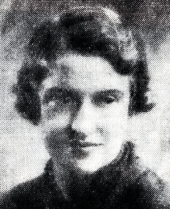Edith Philip Smith

Edith Philip Smith BA PhD FLS DSc FRSE (1897 - 1976) was a botanist and teacher who became a fellow of the Royal Society of Edinburgh and Head of the Botany Department at Queen's College, Dundee.
Career
She was one of the first female graduates to be awarded a degree at the University of Oxford when the first women's graduation ceremony was held there in 1920.[1] She studied at Somerville College, and in June 1920 passed exams in the School of Natural Science with first-class honours, leading to a BA.[2] She then spent a year at Radcliffe College, Massachusetts, and did research in the plant physiology laboratory at Harvard. Next came a period in the Department of Botany at King's College London. In 1925 she was awarded a PhD from the University of Edinburgh.[3] The following year, 1926, she was appointed a Lecturer in Botany at University College, Dundee, which at that time was part of the University of St. Andrews.[4]
Over the next decade Smith published various botanical papers, a textbook and an ecological report of a 1933 expedition to South Rona with scientific colleagues. She spoke about her survey of the island at a meeting of the British Association in Aberdeen. The report was illustrated with several of her own photographs. She told a newspaper that she was "official photographer and cook" for the South Rona team.[5] She created her own "lantern slides" for lectures, both for university lectures and for numerous talks to the public and to local associations, reported in the Dundee newspapers.[6] One article said she was "well known as a brilliant and entertaining lecturer".[7] She was also an exhibiting member of the Society of Scottish Artists.[8]
In 1932 she started the Dundee Soroptimist Club, a group for professional women interested in good citizenship and service to others. Smith was the first president,[9] and in 1935 she was elected president of the National Union of Soroptimist Clubs of Great Britain and Ireland. After a year she resigned that post for health reasons.[10]
She was awarded a Doctor of Science degree from Edinburgh University in 1941 after presenting a thesis called Stelar Structure in the Dicotyledons.[11] Around the same time she addressed the Royal Society of Edinburgh on Studies in the Vascular Anatomy of Trees and Herbs.[12] She became a fellow of the Society in 1953 and two years later was appointed Head of the Department of Botany at the recently restructured Queen's College, Dundee.[13] She retired in 1960 and died on 17 May 1976.[3]
Family
Edith Philip Smith was born in Stirling on 9 March 1897, the eldest child of Edith Abbot Philip and James Cruickshank Smith CBE LittD LLD.[3][14] At that time J.C.Smith was Rector of Stirling High School, but for most of his career he was a senior chief inspector of schools as well as a literary scholar.[15] The family moved away from Stirling in 1899 and lived in Glasgow, Perth and Fife. Smith's obituary described his wife as "sister of Lady Beveridge".[15] Lady Beveridge was the name after her second marriage of Jessie (aka Janet) Thomson Mair née Philip.[16] One of her children was anthropologist Lucy Philip Mair, a first cousin of Edith Philip Smith. Her mother and aunt were amongst the children of a well-educated Dundee joiner and builder running a successful business.[16][14]
One of Edith's three sisters, Amy Moir Philip Pantin née Smith, trained as a zoologist, then became a doctor and member of the Medical Women's Federation.[17] She was married to the zoologist Carl Pantin.[18]
Bibliography
- 1922 Comparative Studies on Respiration XXII. The Effect of Lactic Acid on the Respiration of Wheat, American Journal of Botany, Vol. 9, No. 6, pp307-310
- 1922 A Note on Conjugation in Zygnema, Annals of Botany
- 1924 The Effect of General Anaesthetics on the Respiration of Cereals. I. Carbon Dioxide Production, Annals of Botany
- 1927 The origin of adventitious growths in coleus, Transactions of the Botanical Society of Edinburgh
- 1927 The anatomy and propagation of Clematis, Transactions of the Botanical Society of Edinburgh
- 1928 A Comparative Study of the Stem Structure of the Genus Clematis, with special reference to Anatomical Changes induced by Vegetative Propagation, Transactions of the Botanical Society of Edinburgh
- 1930 Flower colours as natural indicators, Transactions of the Botanical Society of Edinburgh
- 1932 Experimental biology, Oxford
- 1933 The calibration of flower colour indicators, Protoplasma
- 1934 The Vegetation of South Rona, The Scottish Naturalist, no.210
Not a complete list.
References
- ↑ First Oxford Women Graduates - Historic Ceremony, The Times, 15 Oct 1920, p7
- ↑ (Following the Oxford custom a BA not a BSc.) University Intelligence, The Times, 28 June 1920, p10
- 1 2 3 University of Edinburgh Journal, Volume 27, p325
- ↑ The Scotsman, 28 June 1926
- ↑ Aberdeen Journal, 3 September 1934, p6
- ↑ Local newspapers from the late 1920s onward, searchable in archives like britishnewspaperarchive.co.uk
- ↑ Dundee Courier, 20 January 1938 p7
- ↑ Dundee Courier, 9 October 1943
- ↑ Dundee Evening Telegraph 24 May 1932 p4
- ↑ Dundee Courier, 16 April 1936
- ↑ The Scotsman, 13 December 1941, p6
- ↑ Scotsman 2 December 1941
- ↑ Archives Hub: Edith Philip Smith, F.R.S.E., Lecturer in Botany
- 1 2 Birth and census records
- 1 2 Death of Eminent Scots Scholar, The Scotsman, 8 Nov 1946 p4
- 1 2 John Davis, ‘Mair, Lucy Philip (1901–1986)’, Oxford Dictionary of National Biography, OUP 2004
- ↑ Archives: Medical Womens' Federation
- ↑ James Beament, ‘Pantin, Carl Frederick Abel (1899–1967)’, Oxford Dictionary of National Biography, OUP 2004
